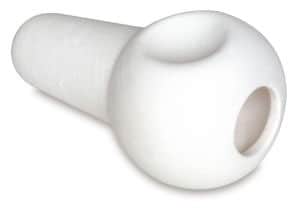Your cart is currently empty!
When do you Close the Peepholes on a Kiln? Essential Facts
Published:
Last Updated:
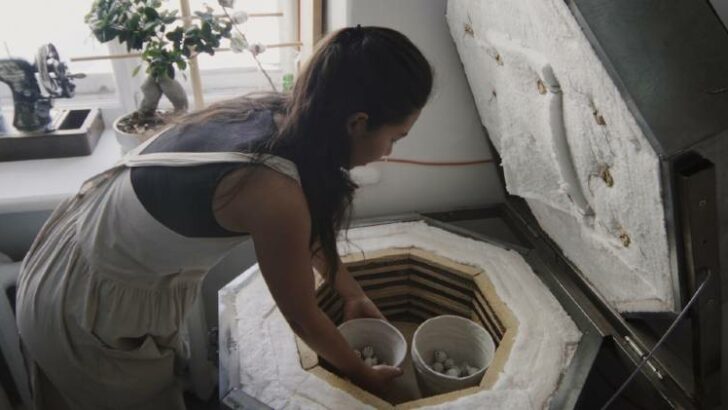
Affiliate Disclaimer
As an affiliate, we may earn a commission from qualifying purchases. We get commissions for purchases made through links on this website from Amazon and other third parties.
Kilns come in all sorts of shapes and sizes. If you have a new kiln, you might be wondering how to use the peepholes. Or perhaps you are having trouble with your glazes and you suspect you can remedy this with the peepholes. Either way, you may have been wondering, when do you close the peepholes on a kiln?
Broadly speaking, the peepholes should be open until between 1100-1200F when bisque firing. This is so that fumes and moisture can escape. After this, the peepholes are closed. Some potters keep a peephole open when glazing. However, with downdraft ventilation systems, all peepholes should be closed.
The question of when you close the peepholes on a kiln is a source of debate amongst potters. Although it’s always a relief to find hard and fast rules about processes, that is rarely the way in pottery.
For every apparently simple solution, you will generally find a number of caveats. And the issue of when to close the peepholes is no exception. Ten different potters will give you ten different answers to when do you close the peepholes on a kiln.
Some potters will say they never keep the peepholes open. Others will say they close them at a certain temperature. And still others will say they never use peephole plugs. So, who is right? Is it necessary to close peepholes? And if so, when is the best time to do it?
The variety of information and opinions can be confusing. In spite of these differences, it is possible to look at the various factors involved and make an informed decision. And that is what this article will help you do, so read on…
When do you Close the Peepholes on a Kiln?
The point at which you close the peepholes on a kiln depends on a number of key factors. But before looking at what these essential factors are, let’s consider what peepholes are for…
First things First – What are Peepholes For?
Firstly, a brief word about what peepholes are and their intended function. Peepholes, also known as spy holes are located on the side of the kiln.
As the name suggests, one of their main functions is to let you look inside the kiln as it fires.
Some smaller kilns have just one peephole. Larger kilns usually have more located up the side. This is so that you can look at what is happening at the various different levels in your kiln. You may have pyrometric cones positioned at different levels in the kiln to check for cold spots. Multiple peepholes will enable you to monitor at each level.
The energy being radiated out of a peephole is intense. So, it’s important to wear special glasses or goggles when you are checking a peephole visually.
Another function of peepholes is to provide ventilation. Some kilns have a flue on the lid, which provides ventilation. Other kilns do not, as such the peepholes play a key role in venting and circulating oxygen during firing.
The stem of the peephole plug is normally tapered. This means that you can use them on different kilns as they will fit different-sized holes.
They are made of lightweight ceramic material, similar to the kiln bricks in your kiln. This means that they can break easily.
However, don’t worry if they break or you mislay them, as it is easy to purchase spares.
So, with that brief overview of the function, let’s consider when they should be open or closed….
The Best Time to Close the Peepholes on a Kiln
Having the peepholes open or closed depends on 3 main factors. They are:
- Whether you are bisque firing, glaze firing, or cooling your kiln
- What ventilation systems you have on your kiln
- The design of the kiln and the manufacturer’s specifications
Bisque Firing – When to Close the Peepholes
During the first part of the bisque fire, your clay undergoes physical and chemical changes. Residual moisture is evaporating, organic and carbonaceous material is burning away, and chemically bound water is being driven out. This stage is known as the ‘burn off stage’ and these processes generate moisture, gases, and fumes.
It’s very important that these by-products of the early bisque fire are allowed to exit the kiln. So, keeping the peepholes open during the early stages of a bisque fire is almost universally recommended.
However, most potters will close the peepholes after the burn-off stage has passed. The temperature at which they close the peepholes does vary a little. Some will close them at 1000F, others wait until around 1200F. Also, some potters will rely on looking at the color of the inside of the kiln to gauge temperature. Others with a digital controller rely on the control panel for a precise reading.
Another way of checking if burn-off is complete is by carefully holding a mirror to an open peephole. If moisture is still exiting the kiln, the mirror will fog up with condensation. Around 1000F the fogginess will start to lessen. The point at which the mirror no longer fogs is the time when the burn-off has finished.
It is at this point in a bisque fire that you can close the peepholes on a kiln.
Why Leave the Peepholes Open During Burn-Off?
The gases and moisture need to exit the kiln during burn-off. If they are not able to escape, they can travel through the soft kiln bricks. The moisture, in particular, can then condense on the inside of the metal kiln jacket and cause rusting.
Also, the mixture of fumes and water can cause corrosion on the electrical elements and wiring in your kiln. This can result in faulty wiring and will likely mean you will have to replace your elements more often.
Also, if your kiln has a kiln sitter, then the fumes and moisture can migrate down the kiln sitter tube. This can cause a build-up of residues in the ceramic kiln sitter tube and affect the way it works. If your kiln sitter stops working, you are more likely to encounter problems with over firing.
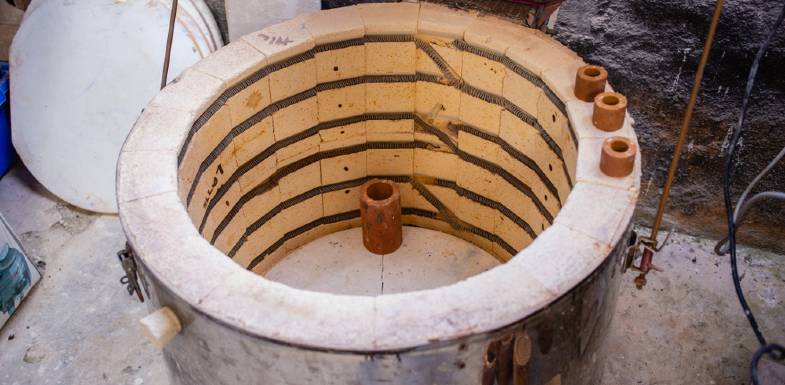
Cracking the Lid?
Some potters also crack the lid of their kiln during the first part of a bisque fire. This basically involves propping the lid of the kiln open as well as leaving the peepholes open.
Potters will use kiln props, fire bricks, or soft ceramic brick wedges to prop the lid. The lid is then closed once the fumes and moisture have burnt out.
There is some debate amongst potters as to whether this is really necessary. Some state that cracking the lid creates more space for gases to exit than a peephole. Others feel that cracking the lid is overkill and that leaving the peepholes open is sufficient.
Whenever there is a debate of this kind, I find it is best to rely on the manufacturers’ specifications. What does the manufacturer recommend? It used to be standard for kiln makers to recommend keeping the lid ajar for burnout. But they often also just recommend open peepholes. All kilns are different and have been tested by their manufacturers. So, relying on their recommendations is probably wise.
There is one circumstance in which leaving the kiln lid open does make a lot of sense. That is when you know that your greenware is still a little damp. If this is the case, you do need to candle the greenware until it’s bone dry to avoid explosions. During the candling period, potters will almost always have the lid of the kiln propped ajar.
Do you Close all of the Peepholes After Burn Off?
It’s usually recommended that after the gases and moisture have been burnt out, all the peepholes are closed.
The reason for this is that if you leave them open, your kiln has to work harder to reach temperature. This means you are using more electricity and it takes longer to fire. What’s more, you are putting the kiln elements under strain if they are fighting to reach temperature.
Most potters will close the peepholes on the kiln after the temperature has gone past 1200F in a bisque fire. Others choose to leave the top peephole open.
Whether you leave the top bung out for the duration of your bisque fire, is a matter of choice. Again, it is best that you consult with the kiln manufacturer to get their guidance on this matter. Some kiln suppliers recommend you close the peepholes on a kiln after 1200F on a bisque fire. Others will recommend keeping the top peephole open for the duration.
Kiln Design
It’s worth noting that some kilns actually have a flue on the top of the lid. The flue is designed specifically to be kept open during the early stage of a bisque fire. It is from the open flue that gases and moisture leave the kiln.
With kilns of this kind, keeping the peepholes open may not be necessary. Often the suppliers of these kilns recommend keeping peepholes closed at all times. Except of course, when you want to use them as a spy hole and have a look inside whilst firing.
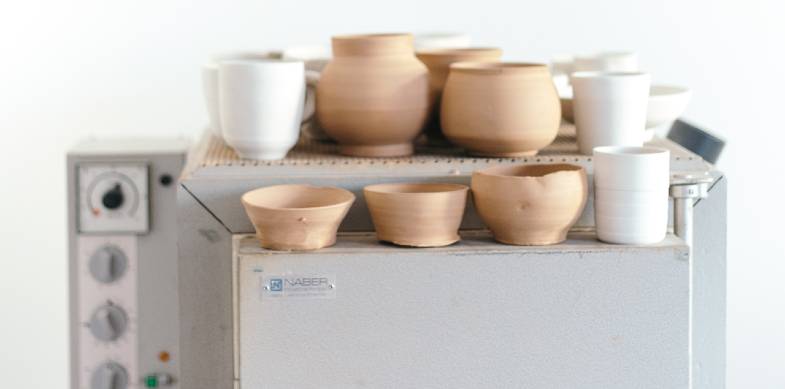
Do You Close the Peepholes on a Kiln When Glazing?
The usual recommendation for an unvented kiln is that you leave the top peephole open during a glaze fire.
One reason is that the pottery still has to go through physical and chemical changes during glaze firing. Glazes create a lot of fumes, and wax resist will smoke and fume as it burns off.
As such gases and fumes are still being created, and these need to exit the internal kiln chamber.
Leaving the top peephole open will give the fumes somewhere to escape, rather than being soaked into the brick. Or damaging the elements or kiln sitter tube.
Some potters actually choose to leave more than one peephole open when they fire. Their rationale is that the increased amount of oxygen brightens the color of their glazes.
However, not everyone agrees with this. Many potters argue that by keeping more than one peephole open, you simply waste energy and lose heat.
Furthermore, there is no particular evidence that keeping more than one peephole open will brighten glazes. In fact, potters who forget to remove any plugs sometimes report that the glazes didn’t look much different after firing.
Also, it’s not uncommon for potters to forget to remove the bungs when firing. Potters will often report that their glazes did not look much different when the bungs had been left accidentally.
Whilst it’s standard advice to leave the top peephole open during a glaze fire, there are exceptions to this.
When to Close the Peepholes During a Glaze Fire
- Open peepholes can cause a localized cold spot in your kiln during firing. If you have a piece of pottery close to the peephole, the lower temperature can compromise your glaze. The glaze can either remain powdery if it’s underfired. Or, sometimes glazes can craze if they are exposed to colder air during firing.
As a result, potters sometimes choose to close the top peephole if they have pots on the top shelf. If you’d rather not close the top peephole, you may need to load your kiln accordingly. Making sure that no pots are too near the open peephole. - The other exception to this guideline is when you are using a downdraft ventilation system. When using a downdraft vent, you need to close the peepholes on a kiln throughout firing. This is an important point, so I will say more about it in the next section.
Ventilation and When to Close the Peepholes
Broadly speaking there are three different ways of venting a kiln. And each requires that you use your peepholes in slightly different ways.
Downdraft Kiln Ventilation
With downdraft ventilation, the fumes and moisture are drawn out of the bottom of the kiln.
When using a downdraft vent, you need to close the peepholes when firing. If the peepholes are open the vent will not work.
The reason for this is that the vent relies on creating a bit of a vacuum in the kiln chamber.
It is this negative pressure that enables the fumes to be drawn out of the bottom of the kiln.
If the peepholes are open the pressure cannot be lowered and the fumes will not be removed.
In addition to this, the temperature in the kiln will be too low to glaze fire effectively.
Some downdraft ventilation systems require that you drill holes in the lid of the kiln, to allow for some circulation. However, drilled holes are much smaller in diameter than peepholes. And not all models require this.
Updraft Kiln Ventilation
With updraft kiln ventilation, gases are drawn away from the kiln out of an overhead vent. A large lid-shaped vent suspends above the kiln and pulls the fumes away.
As such the top peephole needs to be left open. This is so that the fumes and water can leave the kiln and be drawn up by the vent.
Cross Draft Kiln Ventilation
This is the low-tech ventilation option and involves positioning the kiln near an opening window. And using a fan to create a cross draft to blow fumes out of the window.
If you’re using this method of venting, you do need to keep the top peephole open whilst glaze firing. Otherwise, the fumes and gases will be trapped in the kiln.
It’s important that the fan you are using is not blowing directly at the peephole. The fan needs to be positioned so that it is pointing at the other side of the kiln. Otherwise, you risk preventing the gases from escaping and creating a draft going into the kiln.
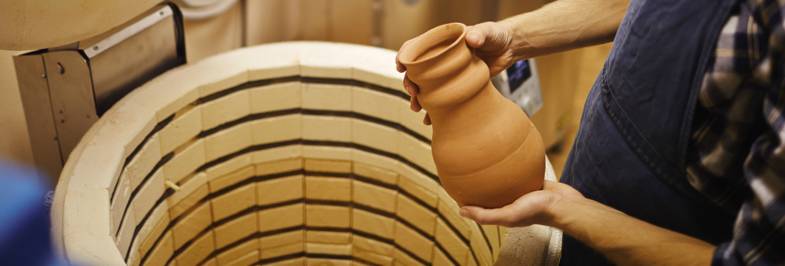
Cooling The Kiln
The peepholes can also be used to enable the kiln to cool down a little quicker. However, it’s important that you wait until the kiln is cool enough before you remove any plugs. If you take them out when the kiln is too hot, you risk the pottery being damaged by thermal shock.
To be on the safe side, it’s recommended that you wait until the kiln is around 200F before removing the plugs. However, some potters will remove the plugs at around 400F
Check the Manufacturer’s Instructions
Different models of kiln will have been tested for optimal performance by the manufacturer. Most kilns will come with specific instructions from the producer about the best way to use their equipment.
Many potters will rely on the manufacturers’ instructions when they are getting to know their kiln. And then experiment a bit once they feel confident in their technique.
Suppliers are usually happy to give guidance on when to close the peepholes on your particular model of kiln.
This article refers to general principles about when to close the peephole on a kiln. If you have questions about a particular model of kiln, it’s sensible to read the manual or talk to the manufacturer.
Final Thoughts
Like many aspects of pottery, when you close the peepholes on a kiln is not written in stone. However, there are some general principles that do apply regardless of the kind of kiln you are using. And these are helpful guidelines, particularly as you are getting to know how your kiln, clay, and glazes respond.

